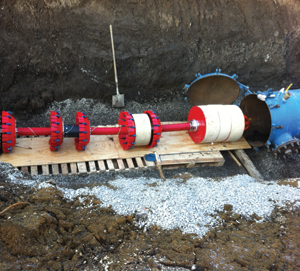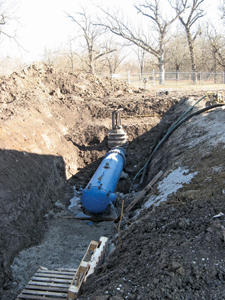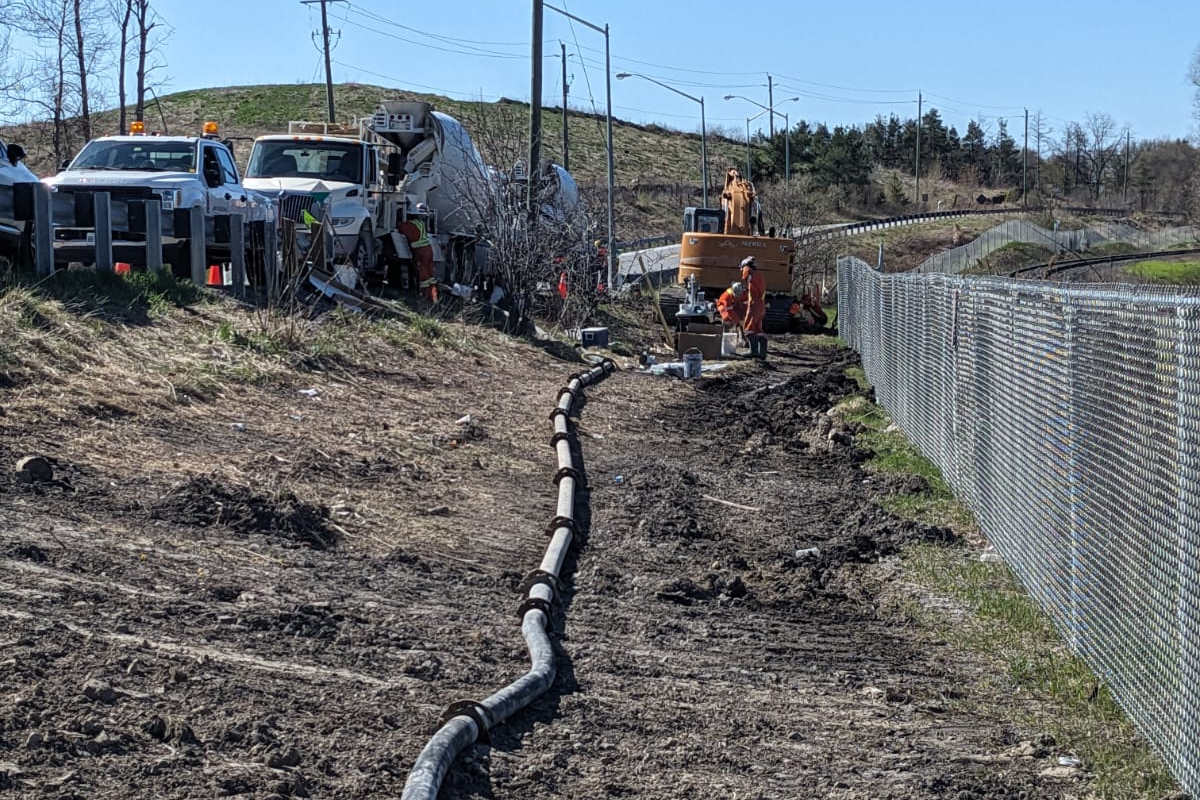Assessing Infrastructure Problems in Missouri
February 15, 2012
 Raymore, Mo., is a small suburb of 18,000 on the south side of Kansas City, Mo. Small, but like all municipalities its size, it has millions of dollars invested in the infrastructure that serves its citizens. Part of this infrastructure is the sanitary sewer force main that pumps half the City’s sewage back up over a ridge to where a gravity sewer carries it to a regional treatment plant.
Raymore, Mo., is a small suburb of 18,000 on the south side of Kansas City, Mo. Small, but like all municipalities its size, it has millions of dollars invested in the infrastructure that serves its citizens. Part of this infrastructure is the sanitary sewer force main that pumps half the City’s sewage back up over a ridge to where a gravity sewer carries it to a regional treatment plant. The force main is 17,500 ft of 24-in., cement-lined, ductile iron pipe that was installed in the early 1990s. The lift station that serves this line was upgraded in 2007 and currently pumps an average of 750,000 gals of sewage per day, operating around 80 to 100 psi. Unfortunately and unexpectedly, this force main has sprung three leaks in the past few years. These leaks cost tens of thousands of dollars to repair, spilled tens of thousands of gallons of sewage into the local creek and left the City wondering when the next shoe would drop.
The sections of pipe that were removed in the repair operations showed corrosion originating on the exterior of the pipe. The pipe had been laid without polywrap protection, leaving it in direct contact with the soil. The City consulted with the Ductile Iron Pipe Research Association (DIPRA), which tested soil samples from the low land pastures where the breaks had occurred. The dozen or so samples all came back “hot,” potentially corrosive to ductile iron pipe.
Ductile iron should last much longer than the 17-plus years this pipe had been in the ground, but now the City was facing the question of how to deal with this valuable and essential asset. One option was to start replacing the line in segments over several years, but besides the obvious problem of cost, there were issues with an already crowded easement and the question if the entire pipe was really ‘bad.’ A couple of excavations for other reasons had uncovered pipe that appeared to be untouched by corrosion.
A second option was just to do nothing, but what if the next break was in the 12,000-ft stretch in the residential neighborhoods? The third option seemed to be “There’s got to be a way to check this line,” but extensive research (read, “Internet”) seemed to indicate that while leaks in potable water lines are easy to find with ultrasonic, broken wires in PCCP pipe are detectable and the oil/gas industry has used Magnetic Flux Leakage technology for years to check their lines, nobody seemed to have the technology to check a DIP force main for external corrosion.
Long story short, the City put out a Request for Proposal across the United States and Canada. PICA responded that it could do Direct Condition Assessment, precise measurements on the line. Not just active leaks, not just average thickness per joint, but accurate measurements of the suspected corrosion.
“Fantastic!” we said, “But how do we get a 14-ft long tool into the line and how do we pull it out of a manhole in the middle of a parking lot?” Local contractor, Redford Construction was hired to remove a 35-ft long dead leg section of the line, install a 24-in. gate valve that isolated a temporary launch barrel (think “big blue torpedo tube”) and to modify the manhole with an oversized lid and vented elbow at the point where the force main turned to a concrete, gravity line. The removed section of pipe also gave PICA technicians the opportunity to further calibrate the tool based on machined defects and naturally-occurring corrosion.
The tool, a Smart Pig” that PICA intended to send up the line is a free-swimming application, pushed along by the flow of fluid in the line. It’s essential to ensure that the bore of the pipeline is intact, no obstacles, nothing for the tool to get hung up on. To verify this, PICA and Raymore conducted a Progressive Pigging Program. Six foam pigs, starting at 22.5-in.diameter/1.5-lb density, working up to the largest and sturdiest at 25.5-in./5-lb density, were pushed up the line by the City’s pumps. The last step in this process was to run a gauge pig. The gauge pig has metal fins that would deflect backward if an obstacle was encountered. No obstacles, the gauge pig emerged, unscathed.
PICA had calculated the estimated inspection time as 19 hours, so a late afternoon launch time was decided upon. While this would require tracking the tool during the night, it would allow for the launch and receive of the tool to take place during daylight hours.
At 5 p.m., on a clear and crisp December afternoon, the tool was turned on and loaded into the launch barrel. Using a low capacity rental pump to propel the tool and its flow meter reading about 375 gpm, the SeeSnake began traveling at 15 ft/minute, a pace optimal for data collection. With Above Ground Markers, PICA technicians were able to track the tool through low land pasture and then residential neighborhoods.
PICA had specifically designed the 24-in. tool to navigate 90 degree bends, so the team was eager to see its performance. The foam and gauging pigs had managed the bends, but the low flow rate required by the tool wasn’t enough to push it all the way around. After a little troubleshooting, one of the city’s pumps was engaged and the 2,500-gpm flow brought the tool around the turn nicely. At this point, the Raymore pump was disengaged and the rental pump was used again.
As the afternoon came to a close and the sun began to set, PICA technicians tracked the tool as it approached the final 300 ft. The city pumps were once again kicked on as the tool navigated the final two 90 degree bends and arrived in the manhole. It was lifted out via backhoe, sanitized and washed. Data quality was confirmed and a full download commenced. The inspection was completed successfully and safely.
The previous break history led Raymore staff to expect some level of corrosion throughout the line, but the extent was not yet understood. Initial analysis of data for the section the breaks had occurred in confirmed some fears but also revealed some surprising information.
Perhaps most notable was the difference between the Average Wall Thickness (AWT) results and the extent of localized wall loss. The AWT alone would suggest that the pipeline was in solid condition as it registered 89 percent thickness, but one of the great features of the PICA tool is its ability to recognize and size localized wall thinning and pitting. This additional information revealed extensive pitting in certain sections of pipe.
 Of the 265 joints analyzed, 30 joints have probable Through Hole indications. These indications don’t necessarily denote leaks (they could be graphitized plugs, the cement liner could still be intact, etc.) but can be thought of as ticking time bombs. These could easily become headaches with a water hammer event, load increases or other similar situations.
Of the 265 joints analyzed, 30 joints have probable Through Hole indications. These indications don’t necessarily denote leaks (they could be graphitized plugs, the cement liner could still be intact, etc.) but can be thought of as ticking time bombs. These could easily become headaches with a water hammer event, load increases or other similar situations.On top of the Through Hole indications, close to 40 percent of the joints contain at least one localized area where the wall loss exceeds 60 percent. On the plus side, of the 5,000 ft analyzed, about 1,700 ft of consecutive pipe was in relatively better condition. There was still evidence of defects, but not in the same abundance or magnitude.
The next step once the final, detailed report is issued will probably be field excavation to verify the data. After that, the path is not yet fixed, possibly analyzing data for the rest of the line, but nevertheless, the City will have a much more informed basis for making decisions on preserving this asset.
Phil Becker is an engineering technician with the City of Raymore, Mo. Chris Garrett is general manager of PICA USA.




